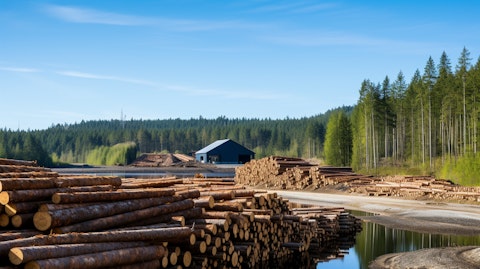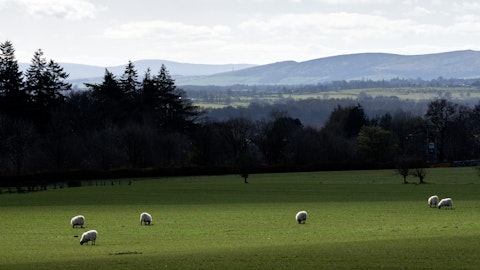West Fraser Timber Co. Ltd. (NYSE:WFG) Q3 2023 Earnings Call Transcript October 26, 2023
Operator: Good afternoon, ladies and gentlemen, and welcome to West Fraser’s Q3 2023 Results Conference Call. Please note that all lines have been placed on mute to prevent any background noise. After the speakers’ remarks, there will be a question-and-answer session. [Operator Instructions] During this conference call, West Fraser’s representatives will be making certain statements about West Fraser’s future financial and operational performance, business outlook and capital plans. These statements may constitute forward-looking information or forward-looking statements within the meaning of Canadian and United States securities laws. Such statements involve certain risks, uncertainties and assumptions, which may cause West Fraser’s actual or future results and performance to be materially different from those expressed or implied in these statements.
Additional information about these risk factors and assumptions is included both in the accompanying webcast presentation and in our 2023 annual MD&A and Annual Information Form, which can be accessed on West Fraser’s website or through SEDAR for Canadian investors and EDGAR for United States Investors. Thank you. Mr. Ferris, you may begin your conference.
Ray Ferris: Well, thank you, operator. And good morning and thank you for everyone joining our third quarter earnings call. My name is Ray Ferris, President and Chief Executive Officer of West Fraser. And joining me today is Sean McLaren, our Chief Operating Officer, who we previously announced will be assuming the role of President and CEO, effective January the first, 2024; and Chris Virostek, our Chief Financial Officer; as well as Matt Tobin, our VP of Sales and Marketing, and several other members of our leadership team. This quarter I am very pleased to inform you that Sean McLaren and I and Matt are joining the call from our OSB Mill in Chambord, Quebec. As I’m sure you are aware, our West Fraser team has been particularly busy this past period with the recently announced divestitures of three of our pulp mills and the acquisition of a sawmill and wood treatment operation and associated forest management agreements in Alberta.
All of these moves are aligned with our long-term strategy to be a premier low cost, sustainable and renewable wood building products producer and key supplier to our customers. Our team has been successfully processing and executing on these announced changes, all the while navigating uncertain, sometimes conflicting, difficult to predict demand fluctuations within the very product and geographic regions we serve. Before I hand the call to Chris Virostek to discuss our third quarter financials further, I’d like to reinforce how thankful and grateful we are for the team at West Fraser for continually adapting to meet the needs of our growing company, in particular to our employees within our pulp team, of which no organization could ask for more.
The dedication and hard work of this is shared and appreciated by all of our nearly 11,000 employees. As we’ll discuss on this call, despite persistently varied and mixed demand markets, we’ve posted strong improvement in EBITDA over the prior quarter. And as we’ll talk further, we’ll also have Sean available to answer questions later in your call as well. But for now, let me hand it back to Chris, who will walk us through our Q3 financial results.
Chris Virostek: Thank you, Ray, and good morning, everyone. And just as a reminder, we report in U.S. dollars and all the references today and our comments will be to U.S. dollars unless specified otherwise. West Fraser generated $325 million of consolidated adjusted EBITDA in the third quarter, improving from the $80 million of adjusted EBITDA reported in the second quarter. Our North American EWP segment generated $289 million of adjusted EBITDA up from $126 million in the prior quarter. OSB strength carried over from – the price strength carried over from the prior quarter. The Lumber segment posted $44 million of adjusted EBITDA this quarter up from 10 million in the prior quarter. This quarter negatively impacted by production curtailments for capital projects as well as extreme weather in parts of Florida and Georgia.
The majority of the sequential improvement this quarter was driven by a $62 million export duty recovery. In the prior quarter, we benefited from favorable changes related to inventory value adjustments – valuation adjustments, while these adjustments were not a significant part of the Q3 results in lumber. The net result was a $35 million negative impact relative to the second quarter on a sequential basis. The Pulp & Paper segment improved, but profitability remains challenging in the third quarter, posting negative $12 million of adjusted EBITDA versus negative $74 million in the prior quarter. As a reminder, last quarter was marked by considerable disruption within the Pulp segment with all four of our pulp mills taking downtime. In Europe, adjusted EBITDA was $4 million in the third quarter as the demand weakness that had begun to unfold late in the second quarter persisted.
These three – Q3 results were down from $19 million of adjusted EBITDA in the second quarter. In summary, price strength across our North American EWP business was the largest positive driver of the company’s sequential EBITDA improvement, which more than offset demand challenges in our Lumber, Pulp and EU segments. Cash flow from operations was $355 million this quarter, and cash net of debt increased to $663 million from $449 million last quarter. This quarter’s cash flow more than covered $25 million of dividends paid and $115 million for capital expenditures. We also repurchased $25 million of shares in the third quarter and a further 53 million between quarter end and October 24. In terms of our operational outlook for 2023, we are reiterating guidance for North American OSB and SPF lumber shipments, but reducing guidance for SYP shipments as market demand for lumber in the U.S. South has begun to cool.
We therefore now expect our SYP shipments to be at the bottom end of the guidance range of 2.9 billion to 3.1 billion board feet. Also, given the weakening trend in European OSB demand, we now expect OSB shipments there to be near the low end of the guidance range of 1 billion to 1.2 billion board feet on a 3/8-inch basis. In terms of capital spending for 2023 based on equipment delivery schedules and spending levels to date, we now anticipate capital investment will be approximately $450 million down from last quarter’s expectation that we would spend near the bottom end of our $500 million to $600 million guidance range. Looking back over the last four quarters, which have undoubtedly been challenging for the wood products industry, our diversified portfolio of assets has generated consolidated EBITDA of $472 million, excluding the $62 million export duty recovery this quarter.

And this trailing 12 months EBITDA would’ve been markedly higher on a pro forma basis after giving effect to the pending sale of the three pulp mills and the pending acquisition of Spray Lake Sawmills. For comparison, this latest level of trough like EBITDA is significantly higher than the financial results generated in similarly weak markets experienced in 2019, which reflects the success of the Norbord acquisition and integration as well as the other mill additions and capital improvements we have made to the West Fraser portfolio in recent years. With that overview, I’ll now pass the call back to Ray.
Ray Ferris: Thank you, Chris. Before I kind of further reflect on our financial performance in the third quarter, I’ll just spend a couple of moments addressing some of the corporate development initiatives we’ve undertaken recently, as Chris has mentioned, namely the sales of these pulp mills as well as the acquisition of the sawmill in Alberta. In early July, we announced the planned sale of our Hinton, Alberta pulp mill to a key strategic partner, Mondi Group plc, which we addressed on our last earnings call. So I won’t spend much time on that transaction other than to say that we now expect the transaction to close early in 2024. Since the Hinton announcement, we also announced the planned sale of our two BCTMP mills namely the Slave Lake Pulp mill in Alberta and the Quesnel River Pulp mill in British Columbia, to Atlas Holdings for $120 million.
Upon closing of this transaction, which is expected in early 2024, these two mills are to be operated by Millar Western Forest Products, a 100-year-old Canadian forest products company that joined Atlas Holdings in 2017. We believe this transaction will provide these great pulp mill assets and teams with a strong strategic future, while also allowing West Fraser to focus its resources on our objective of being a premier wood building products company. This quarter, we also announced the planned CAD140 million acquisition of Spray Lake Sawmills located in Cochrane, Alberta. This transaction includes not just a sawmill and wood treatment facility, which produces a varied value-added treated wood products as well as a variety of innovative wood residuals and other byproducts.
This acquisition also comes with two forest management agreements with a total annual allowable cut of approximately 500,000 cubic meters. With the current expected transaction to close by year-end, this will enable West Fraser to grow its footprint in Southern Alberta and expand its Canadian treated wood business while providing access to a high-quality fiber supply, which is synergistic with our existing sawmill and treating facilities in Sundre, Alberta. We believe over the long-term, that these three transactions are a continuation of our ongoing strategy of always looking to improve our earnings quality through the cycle for the regions and products we serve. Now shifting costs [ph] back to Q3. This quarter, we continue to experience relatively soft demand, particularly in our lumber segment as consumers manage through a period of elevated mortgage and interest rates, which appear to be impacting affordability and overall consumption.
Market weakness was also evident in our European operations, where high inflation and mortgage rates are dampening housing and home improvement markets. Contrast these trends, however, with our North American engineered wood panels business, where we experienced more solid demand through much of the quarter before showing signs of slowing towards the end of the quarter, particularly for our OSB products. With respect to outlook, we expect the wood building products industry will continue to face near-term challenges from factors, including interest rates that may remain higher for longer, ongoing labor constraints, and the potential for muted product demand primarily due to housing affordability headwinds. In recent quarters, we have seen inflationary cost pressures moderate across much of our supply chain, including for raw materials such as energy, resins and chemicals and to some extent, wood fiber, and though difficult to predict, we do expect some upward cost pressure in Q4, particularly for energy-related inputs.
In terms of new home construction and repair and remodeling markets, while we do see demand risks in the near-term, we continue to believe the North American housing market is structurally under built and has an aging housing stock, which, over the mid- to longer term, will should and will support a favorable demand potential for our building products. In closing, while near-term uncertainties exist across the industry in our business, we are confident in the geographic and product diversity we have built and in our operating and growth strategies. Our company has a long and successful track record of steadily and progressively evolving to meet the needs of our employees, our communities and, of course, our shareholders. Including more recently with the acquisitions of Norbord, the modern Angelina sawmill, the large-scale Allendale OSB mill that’s currently in start-up.
Our balance sheet remains strong and well positioned for the future. This team has been through economic and industry cycles before, and we continue to believe we have the people, the assets and financial flexibility to allow us to take advantage of opportunities and overcome challenges when they arise. And although it is unclear when market cycles will turn, we will remain disciplined in our capital allocation strategy, investing in and improving our assets through the cycle. As we look ahead, we will continue to focus on being a low-cost, efficient supplier of renewable and sustainable wood building products, while we remain committed to our prudent capital allocation strategy. and to a future where good fundamentals, support growth in demand for types of sustainable renewable wood products for which West Fraser is known.
Finally, before I turn the call over for Q&A, I thought I would mention a few things about the transition to Sean as President and CEO at year-end. Sean and I have worked very closely together for almost 20 years, both growing together with the company. Sean originally joined with Weldwood Canada based in Vancouver, but has lived and worked across the company from Burns Lake, British Columbia to Hinton, Alberta, both in pulp and lumber, the Sundre, Alberta to Rocky Mountain House laminated veneer lumber to Quesnel Pulp and lumber operations, including two different stints, one in Savannah, Georgia and of course, the last number of years based in our Memphis office in Tennessee. Sean has been a key driver and a leader across multiple business segments and regions, often moving seamlessly between finance and operations roles.
We are so fortunate to have such a strong, knowledgeable and natural people leader in our company, which will support a seamless and efficient transition for all of us here at West Fraser. And for me, I’m very thankful for that. With that, we’ll turn the call back to the operator for questions.
See also 25 Biggest Stocks with Negative Beta and 25 Hottest Selling Products in USA in 2023.
Q&A Session
Follow West Fraser Timber Co. Ltd
Follow West Fraser Timber Co. Ltd
Operator: Thank you. Ladies and gentlemen, we will now begin the question-and-answer session. [Operator Instructions] And your first question is from Hamir Patel from CIBC. Please ask your question.
Hamir Patel: Hi. Good morning. Ray, I saw the Henderson startup, looks like it’s pushed out two quarters. Can you speak to some of the other projects that you might have over the next couple of years? I know you did Opelika and Henderson, but I’m assuming there’s some other ones that are to follow and what sort of scale we could expect in terms of production growth?
Ray Ferris: Well, good morning, Hamir, and good question, and I’ll maybe get Sean to drop in on the end of this one. But before I do that, look, I think one point I’d want to make on Henderson is, I mean, more and all of our capital, it is what I would call full steam ahead. The only thing that slows us down today is really supply chain issues. And look we – and so that’s the only reason for the slight delay, and we’re pretty excited about getting through and seeing that mill start up. With respect to, I’m not sure exactly what we’ve given in guidance. What I would say is we’re continuing to make progress on our – significant progress on our platform – U.S. lumber platform. But we still do have a few more, what I would call excellent projects that we have in the queue.
I don’t think we’ve given a lot of detail on that, but I kind of look at these are ones that we’re going to be very excited to announce them and bring them forward when that time is right and looking forward to having those conversations. So when we think about our future in the U.S. South, it’s one where we see much opportunity to improve what we have both by lowering costs and by growing our footprint. But Sean, anything you want to add to that?
Sean McLaren: No, I think that is a perfect, Ray. I mean we continue to have a number of projects, merchandisers, canter lines, different things that are smaller in nature than Henderson, but really kind of move our cost curve and our competitive position in the U.S. South. So a number of those are in motion and I’m very pleased with the progress on them.
Hamir Patel: Great. Thanks Ray and Sean. Sean, another question I had for you is with the pending sale of most of the pulp and paper assets, do you expect future M&A to be focused on the remaining sort of lumber and OSB businesses? Or do you see some adjacent categories in wood products that might interest the company to grow into either organically or via M&A?
Sean McLaren: Good morning, Hamir. From an M&A perspective, I think you can look at what we’ve done over the last several years that make us stronger. The bar is quite high for us in West Fraser in terms of. We look at a lot of things, but in terms of things that we know will fit into our existing footprint and make us immediately stronger. Our biggest opportunity is modernizing what we have internally. So I think we’ll continue on that path. And if it’s synergistic to our existing business in wood products, we’d look at it, and if it’s a strong addition to the company, we continue to discuss it internally.
Ray Ferris: One thing I’d add on to that, Hamir, is that built into the DNA of the company is I think every day, we sit down and talk about what we need to do and things that we may not have considered yesterday, we might be able to consider going forward as the company continues to change. So I think it’s an ongoing conversation, and as the world changes I’m sure we’re going to continue to look at all things that are out there and figuring out where to take the company.


